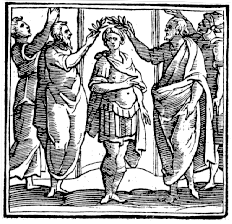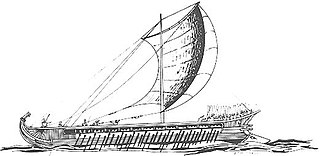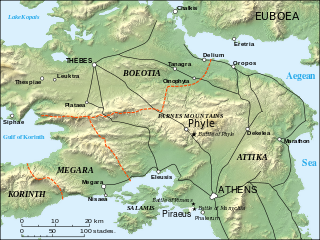
This article concerns the period 409 BC – 400 BC.
This article concerns the period 399 BC – 390 BC.

Lysander was a Spartan admiral (navarch) who commanded the Spartan fleet in the Hellespont. He defeated the Athenians at Aegospotami in 405 BC. The following year, he was able to force the Athenians to capitulate, bringing the Peloponnesian War to an end. He then played a key role in Sparta's domination of Greece for the next decade until his death at the Battle of Haliartus.
Year 403 BC was a year of the pre-Julian Roman calendar. At the time, it was known as the Year of the Tribunate of Mamercinus, Varus, Potitus, Iullus, Crassus and Fusus. The denomination 403 BC for this year has been used since the early medieval period, when the Anno Domini calendar era became the prevalent method in Europe for naming years.

Thrasybulus was an Athenian general and democratic leader. In 411 BC, in the wake of an oligarchic coup at Athens, the pro-democracy sailors at Samos elected him as a general, making him a primary leader of the ultimately successful democratic resistance to the coup. As general, he was responsible for recalling the controversial nobleman Alcibiades from exile, and the two worked together extensively over the next several years. In 411 and 410, Thrasybulus was in command along with Alcibiades and others at several critical Athenian naval victories.

Theramenes was an Athenian statesman, prominent in the final decade of the Peloponnesian War. He was particularly active during the two periods of oligarchic government at Athens, as well as in the trial of the generals who had commanded at Arginusae in 406 BC. A moderate oligarch, he often found himself caught between the democrats on the one hand and the extremist oligarchs on the other. Successful in replacing a narrow oligarchy with a broader one in 411 BC, he failed to achieve the same end in 404 BC, and was executed by the extremists whose policies he had opposed.

The Battle of Aegospotami was a naval confrontation that took place in 405 BC and was the last major battle of the Peloponnesian War. In the battle, a Spartan fleet under Lysander destroyed the Athenian navy. This effectively ended the war, since Athens could not import grain or communicate with its empire without control of the sea.
Critias was an ancient Athenian political figure and author. Born in Athens, Critias was the son of Callaeschrus and a first cousin of Plato's mother Perictione. He became a leading and violent member of the Thirty Tyrants. He also was an associate of Socrates, a fact that did not endear Socrates to the Athenian public.
The Thirty Tyrants were a pro-Spartan oligarchy installed in Athens after its defeat in the Peloponnesian War in 404 BCE. Upon Lysander's request, the Thirty were elected as a tyrannical government, not just as a legislative committee. The Thirty Tyrants maintained power for eight months. Although brief, their reign resulted in the killing of 5% of the Athenian population, the confiscation of citizens' property, and the exile of other democratic supporters. They became known as the "Thirty Tyrants" because of their cruel and oppressive tactics. The two leading members were Critias and Theramenes.

The naval Battle of Cyzicus took place in May or June 410 BC during the Peloponnesian War. During the battle, an Athenian fleet commanded by Alcibiades, Thrasybulus, and Theramenes routed and completely destroyed a Spartan fleet commanded by Mindarus. The victory allowed Athens to recover control over a number of cities in the Hellespont over the next year. In the wake of their defeat, the Spartans made a peace offer, which the Athenians rejected.

The Corinthian War was an ancient Greek conflict lasting from 395 BC until 387 BC, pitting Sparta against a coalition of Thebes, Athens, Corinth and Argos, backed by the Achaemenid Empire. The immediate cause of the war was a local conflict in northwest Greece in which Thebes and Sparta intervened. The deeper cause was hostility towards Sparta, provoked by that city's "expansionism in Asia Minor, central and northern Greece and even the west". The Corinthian War followed the Peloponnesian War, in which Sparta had achieved hegemony over Athens and its allies.
Thrasyllus was an Athenian strategos (general) and statesman who rose to prominence in the later years of the Peloponnesian War. First appearing in Athenian politics in 410 BC, in the wake of the Athenian coup of 411 BC, he played a role in organizing democratic resistance in an Athenian fleet at Samos. There, he was elected strategos by the sailors and soldiers of the fleet, and held the position until he was controversially executed several years later after the Battle of Arginusae.

The Battle of Phyle was fought between Athenian exiles who were seeking to restore democracy to Athens and a Spartan garrison trying to protect the oligarchic Thirty Tyrants. In the battle, 700 Athenian exiles under Thrasybulus decisively defeated the Spartans and their Athenian cavalry in a dawn ambush.

The Battle of Piraeus was fought in 403 BC between Athenian exiles who had defeated the government of the Thirty Tyrants and occupied Piraeus and a Spartan force sent to combat them. In the battle, the Spartans narrowly defeated the exiles, with both sides suffering appreciable casualties. After the battle, Pausanias arranged a settlement between the two parties which allowed the reestablishment of democratic government in Athens.

The Battle of Lechaeum was an Athenian victory in the Corinthian War. In the battle, the Athenian general Iphicrates took advantage of the fact that a Spartan hoplite regiment operating near Corinth was moving in the open without the protection of any missile throwing troops. He decided to ambush it with his force of javelin throwers, or peltasts. By launching repeated hit-and-run attacks against the Spartan formation, Iphicrates and his men were able to wear the Spartans down, eventually routing them and killing just under half. This marked one of the first occasions in Greek military history on which a force of peltasts had defeated a force of hoplites.

Teleutias was the brother of the Spartan king Agesilaus II, and a Spartan naval commander in the Corinthian War. He first saw action in the campaign to regain control of the Corinthian Gulf after the Spartan naval disaster at Cnidus in 394 BC, and was later active in the Spartan campaign against Argos in 391 BC. Later that year, he was dispatched to the Aegean to take command of a Spartan fleet harassing Rhodes. Once in command, he attacked and seized a small Athenian fleet sailing to aid Evagoras I of Salamis, Cyprus, then settled in to attack Rhodes with his newly augmented fleet.

Phlius or Phlious or Phleious was an independent polis (city-state) in the northeastern part of Peloponnesus. Phlius' territory, called Phliasia (Φλιασία), was bounded on the north by Sicyonia, on the west by Arcadia, on the east by Cleonae, and on the south by Argolis. This territory is a small valley about 900 feet (270 m) above the level of the sea, surrounded by mountains, from which streams flow down on every side, joining the river Asopus in the middle of the plain. The mountain in the southern part of the plain, from which the principal source of the Asopus springs, was called Carneates (Καρνεάτης). The territory of Phlius was celebrated in antiquity for its wine. According to Strabo, the ancient capital of the country was Araethyrea (Ἀραιθυρέα) on Mt. Celosse, which city is mentioned by Homer; but the inhabitants subsequently deserted it and built Phlius at the distance of 30 stadia. Pausanias, however, does not speak of any migration, but says that the ancient capital was named Arantia (Ἀραντία), from its founder Aras, an autochthon, that it was afterwards called Araethyrea from a daughter of Aras, and that it finally received the name of Phlius, from Phlias, a son of Ceisus and grandson of Temenus. The name of Arantia was retained in the time of Pausanias in the hill Arantinus, on which the city stood. Hence the statement of grammarians that both Arantia and Araethyrea were ancient names of Phlius. According to Stephanus of Byzantium, Phlius derived its name from Dionysus and Chthonophyle. Phlius was subsequently conquered by Dorians under Rhegnidas, who came from Sicyon. Some of the inhabitants migrated to Samos, others to Clazomenae; among the settlers at Samos was Hippasus, from whom Pythagoras derived his descent.
The Phyle Campaign was the civil war that resulted from the Spartan imposition of a narrow oligarchy on Athens and resulted in the restoration of Athenian democracy.
Phyle was a strong fortress and deme of ancient Attica, on a steep rock, commanding the narrow pass across Mount Parnes, through which runs the direct road from Thebes to Athens, past Acharnae. On the northern side of the pass was the territory of Tanagra. Phyle is situated at the distance of more than 120 stadia from Athens, not 100 stadia, as Diodorus states, and was one of the strongest Athenian fortresses on the Boeotian frontier. The precipitous rock upon which it stands can only be approached by a ridge on the eastern side. It is memorable in history as the place seized by Thrasybulus and the Athenian exiles in Battle of Phyle in 404 BCE, and from which they commenced their operations against the Thirty Tyrants. The height of Phyle commanded a magnificent view of the whole Athenian plain, of the city itself, of Mount Hymettus, and the Saronic Gulf. In Phyle there was a building called the Daphnephoreion, containing a picture, which represented the Thargelia.

Pausanias was the Agiad King of Sparta; the son of Pleistoanax. He ruled Sparta from 445 BC to 426 BC and again from 408 BC to 395 BC.











